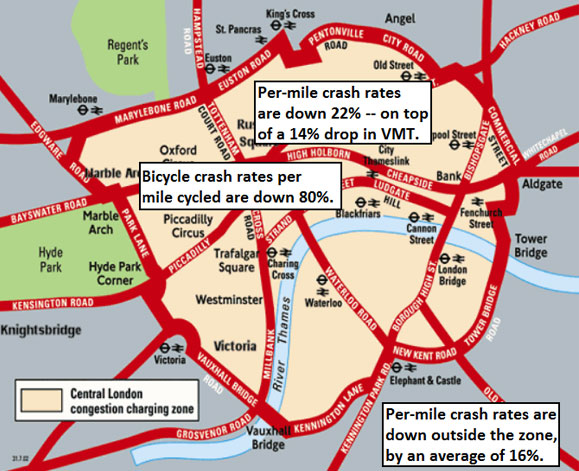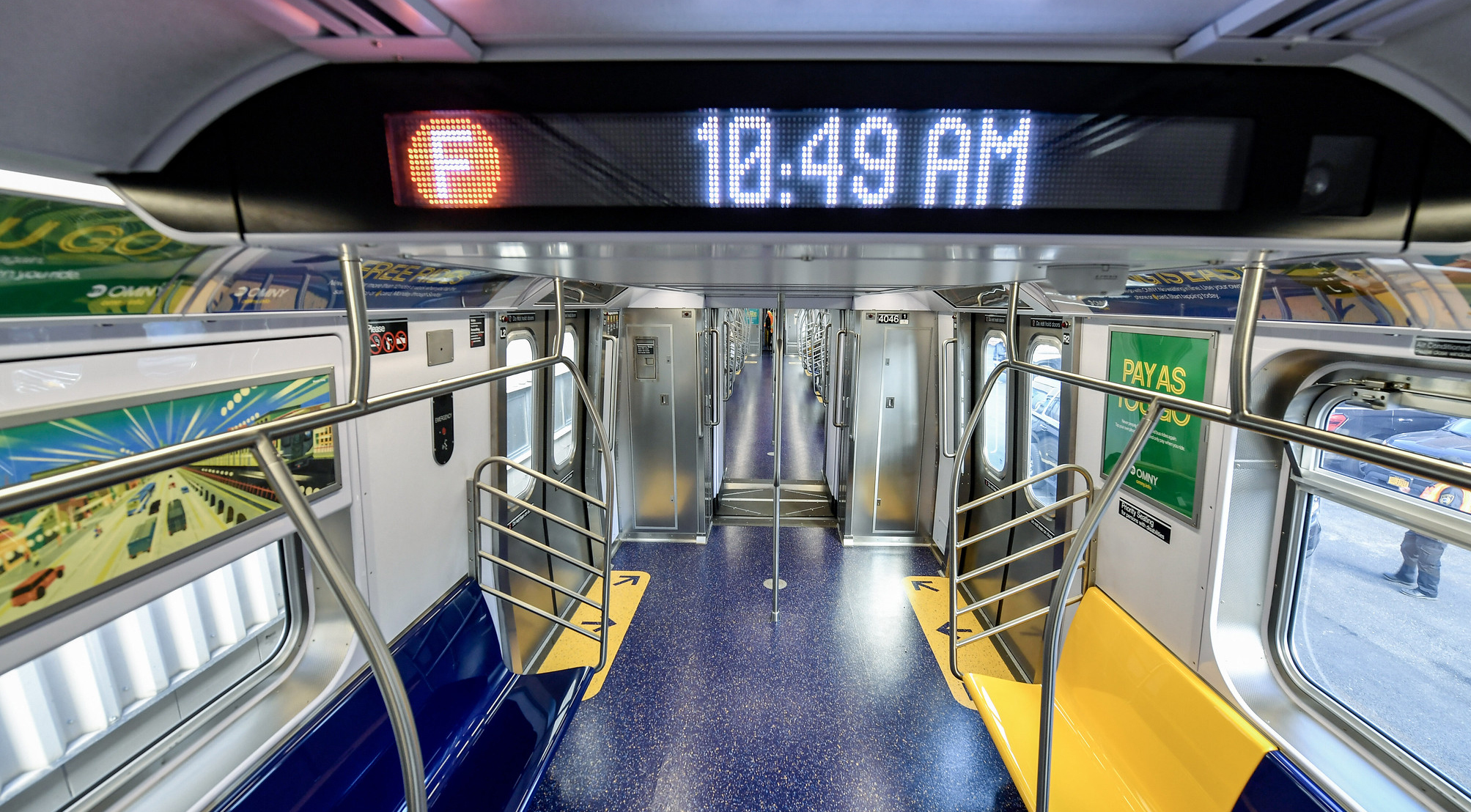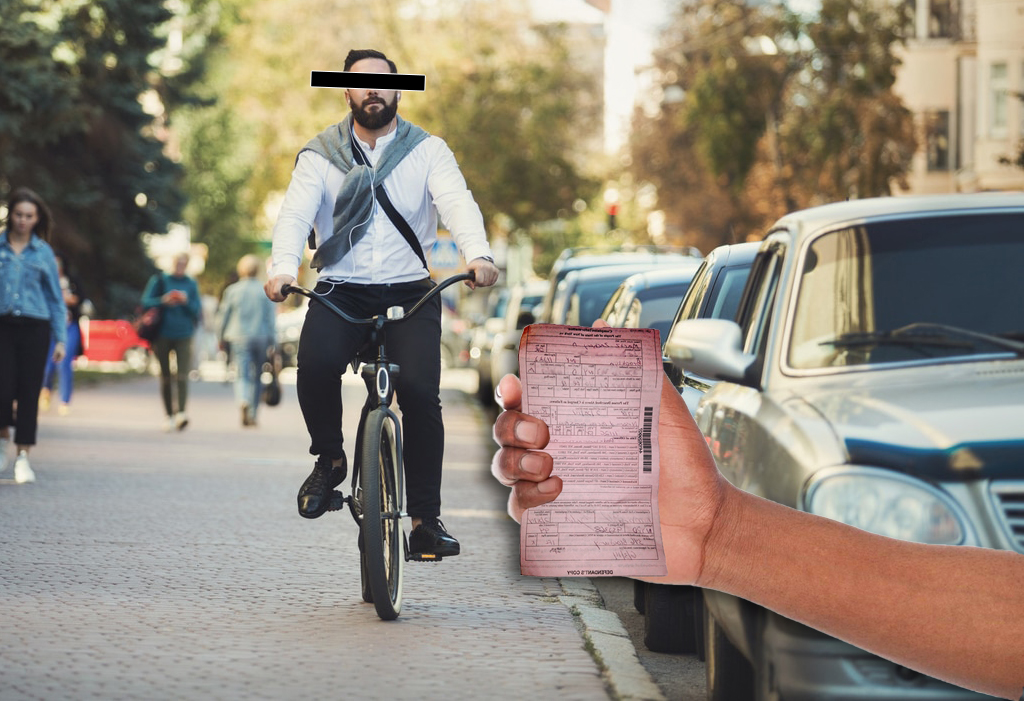
Evidence keeps mounting that congestion pricing can catalyze major reductions in traffic crashes. A year ago I reported on research that vehicle crashes in central London fell as much as 40 percent since the 2003 startup of London’s congestion charge. The same researchers are now expressing the safety dividend in terms of falling per-mile crash rates, and the figures are even more impressive.
The researchers -- economists associated with the Management School at Lancaster University in northern England -- compared crashes within and near the London charging zone against 20 other U.K. cities, before and after 2003. Their conclusion: Since the onset of congestion charging, crashes in central London fell at a faster rate than the decrease in traffic volumes. As important as the reduction in traffic has been for safety, at least as much improvement is due to the lower crash frequency per mile driven.
In short, driving in the London charging zone isn’t just smoother and more predictable, it’s safer. And safer for cyclists as well as drivers, with the number of people on bikes expanding considerably as car volumes have fallen.
The research reported last year was compiled in a working paper, Traffic Accidents and the London Congestion Charge. The new results stressing crash rates (per mile driven or bicycled), rather than crash numbers, appear in the paper’s final, peer-reviewed version published in January in the Journal of Public Economics.
Here are key findings:
- Within the 8-square-mile charging zone, reported vehicle crashes fell from an annual average of 2,626 before the charging scheme, to an average of 1,756 after -- a one-third decline, equivalent to 870 fewer crashes.
- Miles driven within the charging zone during tolling hours shrank as well, from 582 million miles a year, to 500 million -- a decline of 14 percent.
- Expressed per million miles driven, vehicle crash rates within the charging zone fell by 22 percent, from 4.51 reported crashes per million miles driven before the charging scheme, to an average of 3.51 after.
- Shrinkage in vehicle miles traveled is responsible for 370 fewer crashes (4.51 times the difference between 582 and 500), while the remaining 500 fewer crashes are statistically attributable to the diminished per-mile crash rate.
- Crash rates also fell, by around 16 percent, in the “spillover” areas -- the concentric zones up to four kilometers outside the charging zone. The declines, 0.74 crashes per million miles driven, suggest that whatever phenomena have contributed to lower crash rates within the charging zone are operating outside as well.
- The per-mile frequency of KSI (Killed & Serious Injury) crashes fell slightly faster, by 25 percent, than the overall crash frequency, which fell by 22 percent, belying concerns that increased travel speeds enabled by reduced gridlock could worsen crash severity.
These findings pertain to all crashes. The Lancaster researchers also looked separately at bike crashes -- partly to evaluate an earlier report concerned with the uptick in bike crashes after the congestion charge was introduced, and also because of the ongoing interest in cycle promotion and safety in London. The cycling findings are even more positive than the overall results:
- The short-term increase in bicycle crashes with motor vehicles in 2004-2005 was a temporary artifact of a large (66 percent) increase in cycling and the relative inexperience of many of the new cyclists.
- Following this period of adjustment, which also included provision of on-road space for cycling in the charging zone, bicycle crash rates with motor vehicles fell by an astonishing 80 percent within the zone -- from 22.7 crashes per million miles cycled to just 4.6.
- The rate of fatal and severe injury crashes for bicycle riders within the charging zone fell almost as sharply as the total rate of bike crashes -- from 2.9 KSI incidents per million miles cycled, to 0.9, a decrease of 69 percent.
The 80 percent drop in the bike crash rate within the charging zone far surpasses the expected effect of two other likely factors at work. One is a roughly 26 percent decline in bike-vehicle crash rates per motor vehicle that would have been expected on account of the “safety in numbers” phenomenon, whereby the increased presence of cyclists reduces the risk of each mile traveled on bike. The other is the 14 percent decline in motor vehicle traffic noted earlier. Combining both factors yields an expected 35-40 percent drop in the bike crash rate, yet the actual decline rate has been twice as great.
While the researchers are largely silent as to causes of the reduced crash rates, they include an exploratory calculation suggesting that the overall 22 percent decline in the total crash rate within the zone would follow, mathematically, if the motor vehicle trips priced off the streets had been three times as likely to result in a crash as the trips that were not deterred by the toll. While that’s unlikely, it could be that, on average, trips whose intrinsic utility was low enough to have been put “underwater” by the congestion charge tend to be marginal in other respects, including adherence to safety.
The reductions in crash rates following the London congestion charge are striking and cry out for further analysis. Which categories of crashes (vehicle types, proximate cause, location, etc.) have fallen the most, or the least? Are complementary policies such as speed cameras helping to reduce dangerous road behaviors? Is the character of urban driving changing in London, with the greater predictability of auto trips -- not just quicker journeys but fewer unnerving standstills -- enabling a calmer approach to driving that enhances attentiveness, consideration, and due care?
Street safety successes like that reported for the London charging zone don’t come along every day. Saving lives in cities across the globe could turn on fully understanding this good news.





